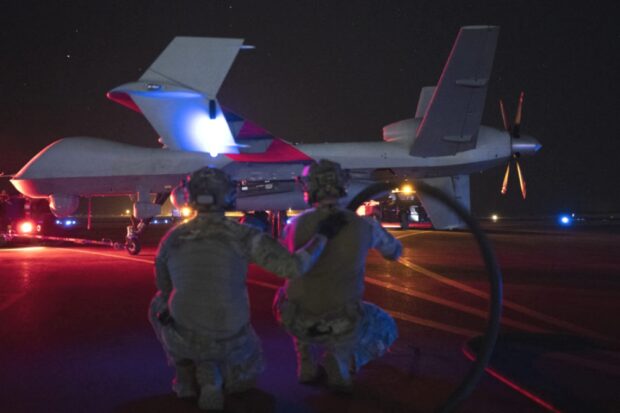A Russian surface-to-air missile came close to striking an American MQ-9 Reaper drone over Syria in November, passing and detonating within 40 feet and damaging the aircraft, according to new details disclosed by a U.S. official to Air & Space Forces Magazine.
The U.S. had already revealed the launch of a Russian SA-22 Pantsir surface-to-air missile against the drone but previously did not disclose the damage or how close the missile came to downing the aircraft Nov. 27. The drone was able to return to base and land safely.
The damage resulted when the missile’s warhead exploded in close proximity to the drone, in what remains the only publicly known instance of a Russian surface-to-air missile firing at a U.S. aircraft over Syria. There have been no other similar missile firings at an MQ-9 over the country since then, according to American officials.
Other U.S. officials acknowledged to Air & Space Forces Magazine the missile came close to hitting the drone, missing by only a few dozen feet. The MQ-9 itself is 36 feet long, with a span of 66 feet.
The Pentagon referred questions about the incident to U.S. Central Command, which declined to comment on the new details.
The disclosure of more details about the November episode comes against the backdrop of increasingly aggressive behavior by Russian pilots in the skies over Syria, according to U.S. officials.
The U.S. still has around 900 troops in eastern Syria supporting local partners in the fight against the remnants of ISIS. Russian forces are also in the country, backing the regime of Bashar Al-Assad against rebel groups.
The U.S. and Russia have established deconfliction protocols to prevent run-ins between their aircraft. But Air Forces Central says Russian warplanes have repeatedly violated that agreement, doing so more than 80 times since March 1, including more than two dozen armed overflights of U.S. troops.
Russian aircraft have also come within 500 feet of American planes during the same period, actions U.S. officials call dangerous. One U.S. official expressed concern that Russia might be trying to “engender an international incident.”
“We’re not seeking to get into a conflict with Russia, nor are we looking to divert attention from why it is that we’re there,” Pentagon Press Secretary Air Force Brig. Gen. Patrick S. Ryder said April 27, in regard to the two nations’ operations in Syria.
Photo: U.S. Air Force Senior Airman Zackary Short, and Keven Torres, forward area refueling point (FARP) specialists assigned to the 26th Expeditionary Rescue Squadron, provide fuel to a MQ-9 Reaper from a HC-130J Combat King II aircraft at an undisclosed location within the U.S. Central Command area of responsibility, Nov. 19, 2022. U.S. Air Force photo by Tech. Sgt. Daniel Asselta
Source: Air & Space Forces

